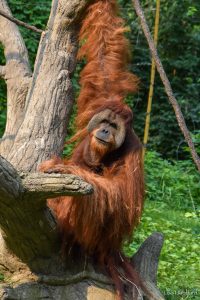Today we celebrate the most endangered apes in the world: orangutans! The Jungle Trails team cares for one special Sumatran orangutan here at the Cincinnati Zoo & Botanical Garden, Henry! Orangutans are considered semi-solitary apes so they spend more time alone than with others. While Henry has had female orangutan companions in the past, he has shown a preference to a bachelor lifestyle which we respect. Henry can often be found “hanging” around with his gibbon friends Lance and Hosen.
Classified as critically endangered, Sumatran orangutans are one of 2 subspecies of orangutan (the other being Bornean). Orangutans are the only non-human great apes found outside of Africa and live in Indonesian and Malaysian rainforests. These apes are the largest tree-dwelling animal and the only true arboreal ape. In fact, the name “orangutan” translates to “man of the forest” in Malay, the official language of Malaysia. Unlike other great apes, which are terrestrial and use a form of locomotion called “knuckle walking”, orangutans are considered modified brachiators. This means while their gibbon friends (true brachiators) may swing from branch to branch, orangutans use their long arms to move carefully from branch to branch. Since they spend a majority of their lives in tree canopies, some of their largest threats are habitat loss and fragmentation, and deforestation.
Some male orangutans develop fatty cheek pads called flange on both sides of their face, which is what gives them a distinct face shape. You can make your own orangutan mask by following the instructions below!
Close Enough to Care:
Monitoring heart health is an important component of caring for the apes at the Cincinnati Zoo & Botanical Garden. We began conditioning Henry, along with the bonobos and gorillas, to receive an awake echocardiogram, an ultrasound of the heart, in 2011. In doing this, we would have the ability to look at how the heart is functioning without having to have the animal under anesthesia.
Along with echocardiograms, blood pressure is another important factor of heart health that can tell us a lot about how our bodies are functioning. Henry’s blood pressure training started in 2018. Like the ultrasounds, there were a great many steps that led up to achieving this behavior. Designing the steel mesh sleeve that Henry would place his arm into, finding the right size cuff, getting Henry used to all of the moving parts and also used to the sensation of the cuff squeezing his arm. His primary trainers worked diligently to make this process a success and Henry’s first readings were recorded in March of 2019! Some modifications needed to be made to make sure the readings were accurate, and now Henry voluntarily has his blood pressure monitored several times a month, as long as there is pineapple involved!”
The Cincinnati Zoo & Botanical Garden, and the Association of Zoos & Aquariums, are both taking action to help orangutans, and you can too! Here’s how you can help:
Handsome Henry
Henry and Lance the Mueller gibbon
Henry and Hosen
